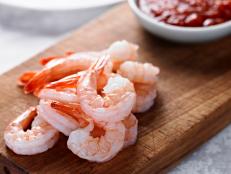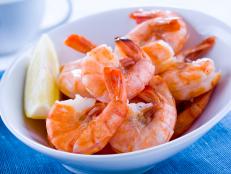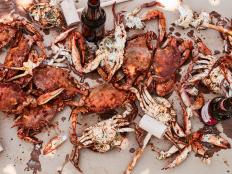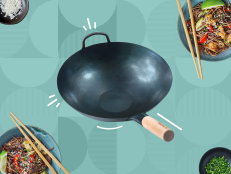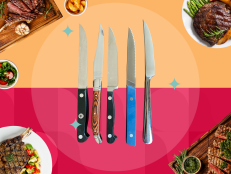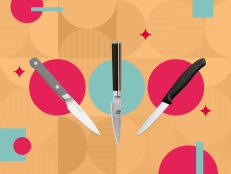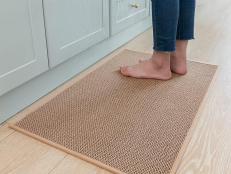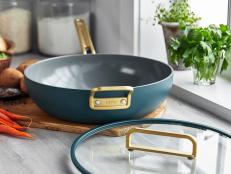How to Shuck Oysters
A step-by-step guide to shucking oysters like a pro — with or without an oyster knife.

By Fraya Berg for Food Network Kitchen
Fraya is a chef and a contributing writer at Food Network.
Shucking oysters can intimidate even the most enthusiastic home cook, but it's perfectly safe to do at home. Here, everything you need to know about oysters, from how to buy them and shuck them to how to serve them raw on the half shell or cook them.

T K / 500px/Getty Images
How to Shop for Oysters
Oysters are typically only sold at grocery stores with fresh fish counters or at seafood markets. If you look at the mesh bag they’re sold in, you’ll see a little tag that indicates where and when they’re harvested. Always ask the fish monger for their best recommendations based on what they have in stock. For more info on oysters, check out A Guide for Buying and Cooking Oysters and our article, A Beginner's Guide to Eating Oysters.
How to Store Oysters
Place a colander inside of a bowl. Line the bowl with newspapers or wet towels, then top with the oysters and a zip top bag filled with ice. Oysters are best enjoyed within a couple days of purchasing them.
How Long Do Oysters Last in the Fridge?
Oysters that have not been shucked will last up to 7 days in the fridge, according to the Washington State Department of Health. Cooked shellfish will last up to 2 days in the refrigerator.
How to Clean Oysters
Oysters can be muddy, and you want to keep them that way until you’re going to shuck them and eat them. Oysters need to be cleaned under running water: they can’t sit in non-moving water, or they will die.
A strong bristle brush or oyster-dedicated toothbrush is the best way to scrub oysters clean. Scrub each oyster until it looks and feels clean, spending a lot of time around the thin back end of the oyster. This area is the hinge of the oyster: a deep crevice that collects mud. Since the hinge is where you’ll first put the knife to open the oyster, you want it to be as clean as possible.
As soon as the oysters are scrubbed, they should be kept on crushed ice.
Shop This Look
How to Shuck Oysters
To safely shuck oysters you'll need some gear: an oyster knife; a no-cut glove (either Kevlar knit or metal mesh); a large stack of cloth towels; and a cutting board. Once you've gotten your supplies together, you're ready to start shucking oysters.
Step one: Fold your cloth. Fold over a cloth towels to make a thick, taco shell-shaped holder for the oyster. Hold the towel in your nondominant hand. You’re using the towel to stabilize the oyster on the board, to provide a shield for your hand and to clean the knife.
Step two: Position the oyster in the cloth. Put an oyster in the towel with the cupped shell on the bottom and the flat shell on top. The hinge end should be facing out, towards your dominant hand.

I_rinka/Getty Images
Step three: Slide in the oyster knife and twist. Place the tip of the knife at the hind of the oyster. Pointing it slightly downward, firmly insert it into the hinge. Twist the knife to pop the hinge open. As soon as you pop the hinge, wipe both sides of the knife on the towel.

I_rinka/Getty Images
Step four: Cut through the top muscle. Go back into the oyster with the knife, holding it parallel and flush to the top shell, and swipe through the oyster to cut the muscle (the abductor) that attaches it to the top shell. If you imagine the oyster as an analog clockface with the hinge at 6:00, the muscle is around 2:00, so aim for that area. Once you’ve sliced the muscle, the top shell will come off. Clean your knife again.

I_rinka/Getty Images
Step five: Cut through the bottom muscle. Holding the oyster carefully so the juices don’t spill, slide your knife under the belly of the oyster and slice through the muscle attachment on the bottom shell. Wipe your knife again.
Step six: Nestle raw shucked oysters in crushed ice. The ice will keep the shells stabile, so the juices stay in the shell.
How to Shuck Oysters Without an Oyster Knife
If you don’t have an oyster knife, you can actually pop open oysters by heating them up or freezing them. Here’s how.

Rennar Oliveira / EyeEm/Getty Images
How to Open Oysters In an Oven or on a Grill
Here, an easy, safe way to open oysters when you’ll be cooking them – or eating them raw (the oysters will open before they cook).
Preheat your oven to 400 degrees F or your grill for high heat.
Prepare a pan with a shallow layer of coarse salt, just enough to support the oysters so they won’t tip and lose all of their juices when they open. Nestle the oysters in the salt. Put the pan in the oven or on a covered grill and cook just until the oysters pop open, about 10 minutes.
As soon as they’re cool enough to handle, use your oyster knife to cut through the muscle that attaches the oyster to the top and bottom shells as described above.
How to Open Oysters In the Freezer
Freeze oysters in a zip top bag at least 6 hours until they’re completely frozen. Then, remove them from the freezer and nestle them in a tray of salt. Transfer them to the refrigerator.
Within the first hour of thawing, the oysters will pop open. Continue thawing them in the refrigerator; once they’re thawed, cut the muscle that holds them to the shells. The oyster will maintain its flavor and texture.
How to Open Oysters In the Microwave
Nestle your oysters in a bed of salt on a plate. Microwave them on high for 40 to 60 seconds and the shells will pop open. Then you can cut the muscle that holds them to their shells.
Oyster Recipes
Now that you're shucking oysters like a pro, put them to use in some of our favorite oyster recipes.

Matt
A quick trip to the grill will open all the oysters you need very quickly. After they open, you can continue to cook them on the grill or serve them on ice with mignonette, bourbon BBQ sauce or scampi butter.

Jason DeCrow
Here, the quintessential step-by-step you need for enjoying raw oysters on the half shell with a classic sauce.

Dan Xeller
The oysters here are cooked, so you can put them on the grill to open them. Then start at the beginning of the recipe and keep going.

Eddy Chen, 2015, Television Food Network, G.P. All Rights Reserved
Giada’s method for serving oysters is unsurprisingly quite glamorous: a dollop of caviar and a prosecco-based mignonette sauce.

Heidi Gutman, 2014, Television Food Network, G.P. All Rights Reserved.
This rich dish was named for the richest man in the U.S. when it was created by Chef Jules Alciatore at Antoine’s in New Orleans in 1889. It’s just as delicious today.
Related Links:

























